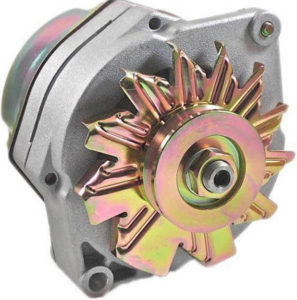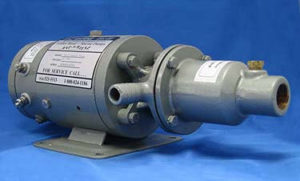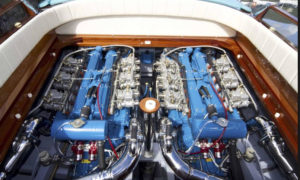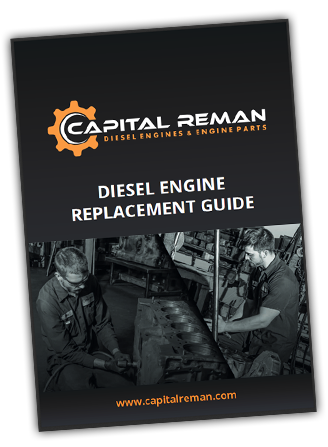Common Differences Between Marine and Industrial Diesel Engines
 Mack E7 Marine Engine
Mack E7 Marine Engine
There is no standard diesel engine for every application. For example there are industrial applications, truck application, electrical power generation, RV applications, heavy duty emergency, pumps and of course marine applications. Although, each engine is slightly different the core design is the same. The exhaust, cooling, electrical and fuel systems are all different in marine engines. This article will discuss the differences between industrial diesel engines and their marine counterparts.
Diesel engines are popular within the marine community for a number of reasons. Unlike, gas marine engines, for the most part there aren't many strictly diesel marine engine manufactures on the market. The big companies like Caterpillar, Cummins and Detroit Diesel build industrial diesel enginesthat are then adapted for the heavy duty marine market. The marine design is based upon millions of other truck or off-road engines on the market. Consequently, Volvo, Yanmar and Perkins all build engines for smaller pleasure craft that work well as drop-in units but do not work well with larger boats.
Marine vs. Industrial Usage Profile:
The common misconception is that industrial engines will not work in marine applications. Industrial diesel engines can be adapted to work in marine craft. For pleasure craft most boats only get roughly 100-300 hours of usage per year. Heavy duty marine applications average usage is 10,000-15,000 hours before overhaul. All marine engines, regardless of application, simply have a shorter expected duty cycle than their industrial counterparts which can often go 500,000 – 1,000,000 miles before major overhaul. The reason for the shorter lifespan is that pleasure craft marine engines will operate at constant high speeds and lower RPMs for a short period of time. If you think about it, speed boats really only travel at high speeds when cruising waterways and open ocean.
Heavy duty marine applications have a similar usage profile as pleasure craft except they operate at full speed for much longer intervals. On the open water there are no stoplights or speed limits. Industrial and truck engines mostly operate at slower speeds and will only go up in RPMs as the transmission briefly shifts 5-6 gears. Marine engines only operate with 1 gear. A common misconception is that a marine engine with low hours is a better engine than one with higher hours. An idle marine engine is prone corrosion and lack of lubrication. Due to the constant use of truck and industrial diesel engines they will often last much longer than their marine brothers.
It is this usage profile that drives the engineering differences between industrial and marine engines. The two main reasons why marine engines are built differently than industrial engines is because of the risk of fire and the corrosion. Marine enginesare subjugated to a constant barrage of humidity and exposure to water. This exposure to water (often times salt water) will deteriorate cast iron and steel pretty quickly if not mitigated. Industrial engines usually operate in dry environments, are stored out of the weather and do not have to worry about fuel leakage on ancillary components or on the road.
Main Differences Between Marine and Industrial Engines:
Starter – The starter on a marine application is coated in an epoxy instead of just regular paint or a bare casting used for an industrial diesel application. The epoxy coating is a rust preventative used instead of aluminum, industrial cast iron or steel material. A marine starter is also sealed at certain points to keep the water out. The casings on a marine starter are spot welded for extra strength to keep from breaking. An automotive or industrial engine, running gasoline and not diesel, can split and allow sparks into the engine bilge. Marine Alternator
Marine Alternator
Alternator – With a marine rated alternator, near the screen there is an additional plate behind the fan. There is also an additional spark arrestor screen on the back. These plates keep a spark from entering the bilge. Engine fires at sea are no joke and every measure to prevent them must be taken.
Distributors – With gasoline powered marine engines the distributor and distributor cap are points of corrosion and fire hazard. The distributor’s job is to route secondary high voltage current to the spark plug so that it may fire in the correct order. This piece of equipment can pose a significant fire hazard and must be upgraded for marine applications. Automotive distributors have an automatic vacuum advance whereas marine distributors do not due to increased risk of a spark. A pressurized vacuum adds stress to the internal components and increases the likelihood of structural failure. Marine distributors contain different internal operating arrangements. The springs are heavier to sustain higher constant RPMs. The points also do not float in marine distributors vs. an automotive or industrial distributor. The spark arrestor vent and distributor caps are also different in marine applications. They are usually made of brass to prevent corrosion. In automotive applications the vent, caps and terminals are all made from aluminum. The brass terminals are actually much better conductors of electricity and stand up to the humid environment much better. Look for electrical components that are rated SAEJ1171; this international rating means the part is safe for marine applications.
Carburetor – Diesel engines do not use a carburetor. A carburetor is a device that blends air and fuel mixture. Diesel engines are all fuel injected and are designed for ignition using compression. Automotive gasoline marine engines that use a carburetor have a strengthened body to prevent fires. Firstly, in marine rated carburetors there is an overflow dam to prevent fuel spillage. Secondly, to prevent fuel flooding issues, there is a strengthened cover over the carburetor and intake manifold. If this chamber floods with fuel it will be contained and go back into the carburetor. There is also an extra bracket to keep the fuel line securely connected to the carburetor. The throttle shifts are grooved in such a way to prevent fuel from puddling. The grooved lines will always keep fuel flowing towards the blades. Marine Rated Fuel Pump
Marine Rated Fuel Pump
Fuel Pump – In a marine application the fuel pump is a dual diaphragm design. In automotive and industrial diesel applications the fuel pump is a single diaphragm design. The reason for the dual design is to create a fail-safe if that compartment ruptures. Especially with gasoline engines if that section fails it will pour fuel all over the bilge. In an automotive application if that diaphragm fails it will spill fuel all over the ground. A high performance marine fuel pump will also contain a bleed-off line if the diaphragm ruptures. The bleed off-line will push fuel back into the carburetor instead of the engine bilge.
Water Pump – Marine water pumps vary differently from automotive or industrial water pumps. Some water pumps are open systems and use raw seawater to cool the engine. Marine water pumps come with stamped stainless steel brackets as aluminum will rust. The majority of the body is either stainless steel or epoxy. Automobile water pumps will most times come without paint and are subject to corrosion. The internal components of the water pump are all manufactured using brass or anodized aluminum. Anodizing is an electrochemical processthat converts a metal surface to a corrosion anodic oxide finish. Automotive or industrial engines will simply use a stamped steel impeller. A marine water pump will feature a brass bi-directional impeller which requires no anti-freeze.
Secondary Differences between Marine and Industrial Engines:
Camshafts – Marine camshafts versus industrial camshafts have different grinds. RV and On-Road Trucks have pretty much the same grinds but marine engines have intake/exhaust valves that overlap. The camshafts usually are ground to have a high lift and shorter duration for more lower end torque at high RPMs not horsepower like many performance camshafts.
Freeze Plugs – In marine engines all of the core plugs are made of brass to prevent corrosion. Coolant passages should also be coated in corrosion resistant material. Marine Epoxy Water Pump
Marine Epoxy Water Pump
Gaskets and Housings – Gaskets are all made with composite plastics. Head gaskets are made with stainless steel to prevent corrosion.
Intake Manifold – The intake is manufactured with dual planes, ceramic rollers and seals.
Bearings – Bearings are typically larger in marine engines to handle constant RPMs. The larger size helps stand up to wear better. Bearings are also corrosion resistant and made of stainless steel.
Pistons – Pistons in marine engines are usually geared towards higher compression. They don’t need the dish style heads. Emissions technology on older marine engines is still subjugated to EPA Tier Ratings and must have exhaust gas re-circulation (EGR), diesel particulate filters (DPF), catalytic converters and diesel exhaust fluid (DEF).
Rings – The rings on marine engines must also take into account for wet environments. The rings are manufactured out of stainless steel or chrome molybdenum.
Blocks – The engine blocks in both industrial and marine applications are generally the same. On the automotive side it is speculated that General Motors sells about 15% of its engine blocks directly to Mercruiser. There really is no difference between the blocks. If the engine blocks are used in freshwater applications there really isn’t too much additional need as far as corrosion technology goes. The sumps are sometimes built with copper or brass but is not typically standard. Marine rated blocks are sometimes all coated in anti-corrosion spray to avoid moisture. When the block does break down it turns into a powder or shale that is easily expelled via the cooling system. Automotive / Industrial Engines that breakdown can block oil and water passages. For heavy duty marine applications some engine blocks are rated stronger than their industrial counterparts to handle sustained RPMs. Specific marine rated blocks are sometimes casted with more nickel to prevent corrosion. Overall the torque curve with marine engines is different than truck engines. With marine diesel engines they are constantly at 4,500 – 5,000 RPMs for hours on end. Truck engines only sustain high RPMs for a short period before shifting to a different gear. Marine rated engine blocks will be manufactured with the additional heat and pressure of sustained RPMs.
Overall the torque curve with marine engines is different than truck engines. With marine diesel engines they are constantly at 4,500 – 5,000 RPMs for hours on end. Truck engines only sustain high RPMs for a short period before shifting to a different gear. Marine rated engine blocks will be manufactured with the additional heat and pressure of sustained RPMs.
Cylinder Head, Rods, Crankshaft – Every part of the engine can be adapted for marine rated. Aftermarket companies will sell performance cylinder heads, connecting rods and even marine rated crankshafts. However, for most drop in diesel engines you do not need to specifically install marine rated heads, connecting rods or crankshafts.
Overall, marine and industrial strength diesel engines are not much different from a design perspective. It really boils down to the various ancillary parts that are built for corrosion or fire prevention. It is always best to check with a marine mechanic to make sure an industrial diesel engine will work with the application you have. Running the engine serial number before you purchase is crucial to getting the engine that will work for your needs.




